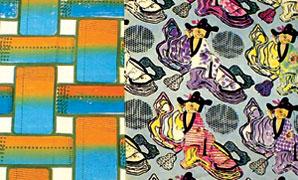Retro Hand-Printed Textiles
dal 15/7/2002 al 27/9/2002
Segnalato da
Design Museum, at University of California
15/7/2002
Retro Hand-Printed Textiles
Design Museum, Davis
A Visual Remembrance from the Studios of Katherine Westphal and Ed Rossbach. A 'retro' exhibition of hand-printed textiles from the late 1950s to 1970s, plus a few examples of commercially printed textiles from the early '50s.

a Visual Remembrance from the Studios of Katherine Westphal and Ed Rossbach
This summer for the first time, the
Design Museum at University of
California, Davis will be open to
visitors, luring them in with a "retro"
exhibition of hand-printed textiles
from the late 1950s to 1970s, plus
a few examples of commercially printed textiles from the
early '50s. The designs are all the work of internationally
recognized designers Katherine Westphal and husband Ed
Rossbach, both of whom are credited with pioneering new
approaches and techniques in the field of fiber arts.
Some of the textiles are dated, and illustrate a progression
in image, technique, dye and materials--a visual history of
the change in ideas about textile printing, materials, and
new technology. These hand-printed fabrics used the
simplest of processes, borrowed from all over the world:
block prints from India and Iran, batik from Indonesia,
shibori from Japan, stencil and tie dye from Africa.
"In the '50s and '60s," says Westphal, "hand-printed
textiles were thought of as exhibition pieces." At that time
there were juried exhibitions of hand-printed textiles.
Galleries required a three-yard length of both textile
printers and hand weavers, for the sake of uniformity and
ease of installation. There were regional exhibitions
throughout the United States. The Richmond Art Center
and the Rotunda gallery in the City of Paris department
store in San Francisco featured yearly shows.
Selections from the 1950s are in large part designs for
industry, commercial roller prints adapted from the
dye-on-cloth repeat designs. In designing textiles for
commercial purposes, Westphal and Rossbach produced
design using many variations of hand-printing and drawing
(one-and-a-half repeat) on small pieces of cloth, which
were then produced by Perspectives Inc. of New York.
"I wonder today what we thought we were doing," says
Westphal, "designing for industry, or proving we could print
or weave a textile that the layman could not distinguish
from commercial yardage. Although we borrowed
techniques from ethnic textiles, we persisted in imitating
the commercial textiles."
Throughout the '50s and '60s, textile artists became "world
travelers" as they learned, borrowed and mixed Japan and
Indonesia, Africa and Italy.
"The three-yard length became less compelling," says
Westphal. "Gradually, the textiles took on a new
look--shaped, embellished, cut up, collaged, or stuffed.
Textile artists thought of their work as art, not as a
service for industry. The passion was in the process. It
was an interaction of the individual spirit and the materials,
cloth and dye. A connection between producer and
product, an endless search for meaning and expression. As
it becomes the center of one's thought process, questions
arise. What will happen if I break the rules? The challenge
is constant. What if...?"
"In the '70s, textiles became like paintings, influenced by
ideas. A new aesthetic developed. It was a different time;
the idea or process was the challenge."
Many of these textiles designed by the Rossbachs no
longer exist, having been cut up and reassembled into
"objects" or clothing. "A printed textile has to be something
in a craft-oriented world," says Westphal.
"As time passes" she adds, "everything changes. We
expect things to happen fast. Our lives are fractured, the
computer designs for us. We look back and wonder how we
had the time and patience to be involved with such a
labor-intensive activity as hand printing a three yard
length of fabric. It was a love affair with color patterns on
cloth.
"Today as I look at these pieces from the past I wonder
'Why? What did I think I was doing? Why have I kept
them? Some of them still speak to me, others are
expendable. How do I shed these things which have
become an albatross around my neck. Change is
necessary, we look forward and we also look back."
Design Museum, at University of California, Davis
Davis, CA, USA United States of America
Phone 530-752-6150



